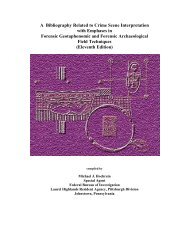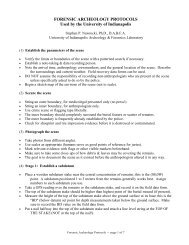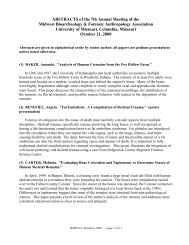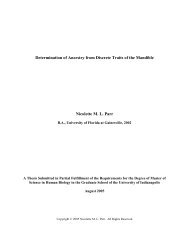Abstracts - University of Indianapolis Archeology & Forensics ...
Abstracts - University of Indianapolis Archeology & Forensics ...
Abstracts - University of Indianapolis Archeology & Forensics ...
Create successful ePaper yourself
Turn your PDF publications into a flip-book with our unique Google optimized e-Paper software.
(23) DEL PINO, David. "Forensic Anthropology and Human Rights: Genocide and the<br />
Disappeared." (poster presentation; abstract not available)<br />
(24) POLLI, Maura. "The Underclass in an Historic Industrial Community: The Role <strong>of</strong><br />
Enamel Hypoplasia Studies in Population Health Models."<br />
Nutritional conditions affecting historic populations may be inferred from skeletal remains in<br />
general and specifically from dentition. A nineteenth and early twentieth century pauper cemetery<br />
(1885 - 1925) in Milwaukee Co., Wisconsin provides an unique opportunity to further examine current<br />
use <strong>of</strong> enamel hypoplasia as an indicator <strong>of</strong> stress. A subset <strong>of</strong> the original 1649 individual population<br />
(approximately 10%) was used to (a) test the sensitivity <strong>of</strong> particular teeth to developing bands <strong>of</strong><br />
enamel hypoplasia, (b) to measure the frequency <strong>of</strong> childhood stress in the underclass <strong>of</strong> an<br />
industrializing community, (c) seek comparison data with other populations (prehistoric through<br />
contemporary) and, (d) to exam how this population fits the model <strong>of</strong> declining age <strong>of</strong> incidence.<br />
Confirming previous studies, mandibular canines were found to be most sensitive to systematic stress<br />
while the total incidence <strong>of</strong> enamel hypoplasia (<strong>of</strong> anterior teeth) in this population is approximately<br />
65%.<br />
(25) SCHMIDT, Christopher, Stephen NAWROCKI, & Matthew WILLIAMSON. "The<br />
Recovery <strong>of</strong> Dermatoglyphs from Recently Mummified Human Finger Tissues."<br />
In October <strong>of</strong> 1994 the badly decomposed body <strong>of</strong> a middle-aged white female was found along a<br />
road near Greenfield in Hancock County, Indiana. Remaining s<strong>of</strong>t tissues were damaged by carnivores<br />
and/or extensively mummified. A death scene investigator removed the dessicated fingertips and<br />
preserved them in an unsuccessful attempt to recover dermatoglyphs and establish positive<br />
identification. A review <strong>of</strong> the literature produced a solution developed in 1921 to rehydrate Egyptian<br />
mummy tissue. After some experimentation we used it to rehydrate a single fingertip, allowing the<br />
recovery <strong>of</strong> the fingerprint. Unfortunately, the individual remains unidentified. (NOTE: see Schmidt<br />
C et al. 2000. Obtaining fingerprints from mummified fingers: A method for tissue rehydration<br />
adapted from the archeological literature. Journal <strong>of</strong> Forensic Sciences 45:874-875).<br />
(26) SMITH, Maria. "Age and Gender Bias in Populations from the Rio Grande Valley, New<br />
Mexico."<br />
The sites <strong>of</strong> the Alfred Herrera and Pueblo Del Encierro from the Rio Grande Valley <strong>of</strong> Central<br />
New Mexico exhibit a distinct age and gender bias in the recovered skeletal sample. There is a<br />
disproportionate representation <strong>of</strong> mature females. Other sites in the southwest, such as Point <strong>of</strong> Pines,<br />
Grasshopper Pueblo and Black Mesa, also report female age and/or gender bias. The cause <strong>of</strong> the<br />
disparity has never been fully addressed despite some authors attempts to deal with recovery bias.<br />
Mortuary treatment as well as recovery bias will be examined at Alfred Herrera and Pueblo Del<br />
Encierro in the hope that the source(s) for the sample bias will emerge.<br />
(27) SWENSON, Diana. "Partially Decomposed and Mummified Remains from North Dakota."<br />
In October <strong>of</strong> 1995, the decomposed and partially mummified body <strong>of</strong> a 32 year old female was<br />
discovered in Rapid City, South Dakota. She was approximately 18 months postmortem. The<br />
procedure for processing the remains and the analytical protocol will be discussed. Antemortem<br />
pathological features will also be discussed in relation to their utility in identification.<br />
BARFAA <strong>Abstracts</strong> 1996 -- page 6 <strong>of</strong> 8








